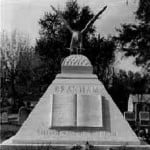One of the reasons Pentecostalism is both academically fascinating and personally invigorating is because of its ability for religious innovation. Its pneumatic drive make it a daring mix of high tension piety and effervescence (thank you Emile Durkheim). Independent evangelists have had more of a hand in crafting their own brand of Pentecostalism since they tend to be free of the denominational structures imposed by hierarchies whose survival depends on securing the borders of orthodox belief and practice. William Branham was one of the most intriguing Pentecostals of the mid 20th century, and as always, depending on whose history and theology you buy–was either a charlatan, prophet, heretic, modern-day Elijah, trickster, or Messenger of the Seventh Age.

Every Easter, a group of Branham’s followers visit his grave in Jeffersonville, Indiana and await his resurrection, which will be the sign that Jesus’ Second Coming is at hand. Branham’s grave attracts hundreds of domestic and international visitors who believe, as Branham prophesied, that he was the messenger of the Last Days. This was not the only unusual view that Branham held. Branham believed that women were forbidden from holding any ministry position, and called women who wore make-up, “dog-meat.” With his prophecies of the Seven Ages, Branham contributed to a long-standing belief that the Roman Catholic church would have a negative role to play in the end-time schema, though depending on which Branhamite website you go to, the anti-Catholicism is more virulent on some–but it is there nevertheless. We will look at Branham’s Seven Age prophecies in a minute, first, a little background.
Branham was born in a log cabin in Kentucky in 1909. The hagiographic re-telling of his life story begins with his infancy, where as Branham tells it, he had a glowing angelic presence aside him sincebirth. This presence later will be a constant in Branham’s ministry, he describes it as a guardian angel, his followers later change it to “Pillar of Fire,” perhaps because the use and role of angels in Pentecostalism has a mixed history, especially when claiming some kind of agency, these angels start to look–well–too Catholic. Branham’s angels walk around his various places of ministry, they tell him about people, their illnesses, their problems–in effect, they are the catalysts for what Pentecostals call “words of knowledge,” information gleaned from a divine source about people that one would not know otherwise. Branham was also a Oneness Pentecostal, attributing belief in the Trinity to unbiblical interpretation of particular texts. Branham’s followers seem to have continued that line of theological thinking, and in some cases, invoke the presence of ministering angels as Branham did, but more so outside the U.S.

Belief in Branham is global. There are at least 6500 ministers worldwide who align themselves at least in part with Branham’s prophetic ministry, in total about 2 million followers, many in the 2/3 world. A quick look at where Branham’s ministry, the Voice of God, is located, Angola, Philippines, Argentina, Benin, Bolivia, India, Togo, and South Africa among dozens of other countries says much about what researchers have told us about global Pentecostalism. First, its more supernaturally inclined than U.S. variety–healing and prophecy being staples of Pentecostal practice. Second, its theological fluidity allows for the Oneness variety to be accepted more readily, mostly because Pentecostalism is popular because it is viewed as working for everyday needs.
Out of the 1100 sermons and messages that Branham left his followers (all searchable online), the few that have garnered most attention are his prophecies concerning the Seven Ages. Many of these prophecies have been prominent since the beginning of the bible prophecy movement of the late 19th/early 20th century. These prophecies reinforce the political and cultural roots out of which they are shaped and re-trained to appeal to like-minded theological allies. The first three prophecies: the invasion of Ethiopia by Mussolini, U.S. entanglement in a war with Germany, and the rise of Fascism, Nazism, and Communism–which eventually all become part of a global communism movement, are all fairly typical politically motivated prophecies, setting up what is most important for Branham’s followers, and indeed many contemporary Pentecostals who follow prophetic musings–that Communism is a part of the eternal struggle–so anything that smacks of it has to be resisted.

The next prophecies, technological advances such as an “egg-shaped” driverless car also marks the beginning of the end (truth be told, I don’t find Smart Cars theologically problematic as much as I find them annoying). This prophecy plays into the penchant that some Pentecostals have to eschew scientific and technological innovations as dangerous because they are created outside of God’s controlling power. ( In a few weeks, I will tell you about the co-worker who cautioned me not to use my ATM card fearing it would lead to the mark of the Beast–to which I replied I would not be using my card–because I was broke, she seemed relieved nevertheless).
Prophecy number five we will bracket till next time when we re-visit Pentecostal dress codes, in particular, all the things women do that drive Pentecostal men crazy—yes, we are going to talk about hairstyles and make-up, something my daughter will be thrilled about. Suffice to say, one of the marks of the end-times is the “fast moral decay of women, [where] she soon began to wear clothes that were too revealing, she bobbed her hair and and adopted the clothing of men.” More next time.
Prophecy Six and Seven have the U.S. at the center, which, if you are curious, is always a good sign that the prophecy is made in the USA–since we are always the center of our own universe, even in bible prophecy. Prophecy Six relates the loss of U.S. power to the whore of Babylon, (Roman Catholic Church), and presumably the loss of Protestant America means that the U.S. has given up any legitimate right to theological supremacy. With that prophecy seven ends with the destruction of the U.S. in a nuclear attack (Russia always figures prominently here somehow).

Branham had another divergent view, called the “serpent’s seed” view of Genesis, where Eve has sexual relations with the serpent, thus giving rise to a race of inferior and cursed human beings–that historically this view has been used to promote white supremacy and African American inferiority, (through British Israelism for example), is a theology that is refuted with regularity by Branham’s detractors. Even his followers do not like to make the nexus between the theology and its racial implications, but others have already done so–for centuries. That this view, or the prophecies, or the views about women, and yes, even the (non)resurrection of Branham do not affect his popularity perhaps says much about how people structure their belief.
People’s plausibility structures are stretched out to the max–people are willing to suspend their own disappointment, entertain divergent views, accept the anti Trinitarian, anti-Catholic, anti-women views–simply because they want to believe. According to sociologists who study prophetic movements, people predisposed to prophecy have created ingenious ways of moving the yardsticks of what constitutes prophecy, proof, and belief because it is necessary for the effervescence of the movement to continue to motivate them to promoting Branham’s life as nearly divine and their spiritual lives as meaningful.
Next time–Hair and Make-Up Tips from the Pentecostal Subcutlure
















